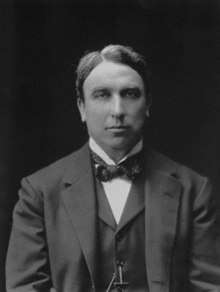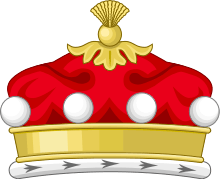Arthur Samuel, 1st Baron Mancroft
Arthur Michael Samuel, 1st Baron Mancroft (6 December 1872 – 17 August 1942), was a British Conservative politician.
The Lord Mancroft | |
|---|---|
 | |
| Chairman of the Public Accounts Committee | |
| In office 1929–1931 | |
| Preceded by | William Graham |
| Succeeded by | Morgan Jones |
| Financial Secretary to the Treasury | |
| In office 1 November 1927 – 5 June 1929 | |
| Prime Minister | Stanley Baldwin |
| Preceded by | Ronald McNeill |
| Succeeded by | Frederick Pethick-Lawrence |
| Secretary for Overseas Trade | |
| In office 4 November 1924 – 1 November 1927 | |
| Prime Minister | Stanley Baldwin |
| Preceded by | William Lunn |
| Succeeded by | Douglas Hacking |
| Member of the House of Lords Lord Temporal | |
| In office 23 December 1937 – 17 August 1942 Hereditary peerage | |
| Preceded by | Peerage created |
| Succeeded by | The 2nd Baron Mancroft |
| Member of Parliament for Farnham | |
| In office 14 December 1918 – 23 March 1937 | |
| Preceded by | County constituency |
| Succeeded by | Godfrey Nicholson |
| Personal details | |
| Born | 6 December 1872 |
| Died | 17 August 1942 (aged 69) |
| Political party | Conservative |
Background
Lord Mancroft was the eldest son of Benjamin Samuel, of Norwich (19 April 1840 – 16 April 1890), and Rosetta Haldinstein (died 29 April 1907, daughter of Philip Haldinstein and wife Rachel Soman), and grandson of Michael Samuel (1799–1857), all of them were Ashkenazi Jews.
Early life
He was educated at Norwich School.[1] He was Lord Mayor of Norwich from 1912 to 1913 and was made an Honorary Freeman of the City of Norwich in 1928.
Member of Parliament
In 1918 he was elected as Member of Parliament (MP) for Farnham, a seat he would hold until 1937, and served under Stanley Baldwin as Secretary for Overseas Trade from 1924 to 1927 and as Financial Secretary to the Treasury from 1927 to 1929. He was also chairman of the Public Accounts Committee of the House of Commons in 1930 and 1931. Samuel was created a Baronet, of Mancroft, in the City of Norwich in the County of Norfolk, on 15 January 1932,[2] and on 23 December 1937, he was raised to the peerage as Baron Mancroft, of Mancroft (referring to the area around St Peter Mancroft church) in the City of Norwich.[3]
Family
Lord Mancroft married Phoebe Fletcher, daughter of George Alfred Chune Fletcher and wife, in 1912. He died in August 1942, aged 69, and was succeeded in the baronetcy and barony by his son Stormont Mancroft, 2nd Baron Mancroft. He was also to become a Conservative government minister.
The papers of Lord Mancroft are in the Churchill Archives Centre, Churchill College, Cambridge.[4]
Arms
 |
|
References
- Who's Who 1938, page 2220
- "No. 33791". The London Gazette. 19 January 1932. p. 419.
- "No. 34375". The London Gazette. 26 February 1937. p. 1324.
- http://janus.lib.cam.ac.uk/db/node.xsp?id=EAD%2FGBR%2F0014%2FMNCR
- Kidd, Charles, Williamson, David (editors). Debrett's Peerage and Baronetage (1990 edition). New York: St Martin's Press, 1990.
| Parliament of the United Kingdom | ||
|---|---|---|
| New constituency | Member of Parliament for Farnham 1918–1937 |
Succeeded by Godfrey Nicholson |
| Political offices | ||
| Preceded by William Lunn |
Secretary for Overseas Trade 1924–1927 |
Succeeded by Douglas Hacking |
| Preceded by Ronald McNeill |
Financial Secretary to the Treasury 1927–1929 |
Succeeded by Frederick Pethick-Lawrence |
| Peerage of the United Kingdom | ||
| New title | Baron Mancroft 1937–1942 |
Succeeded by Stormont Mancroft |